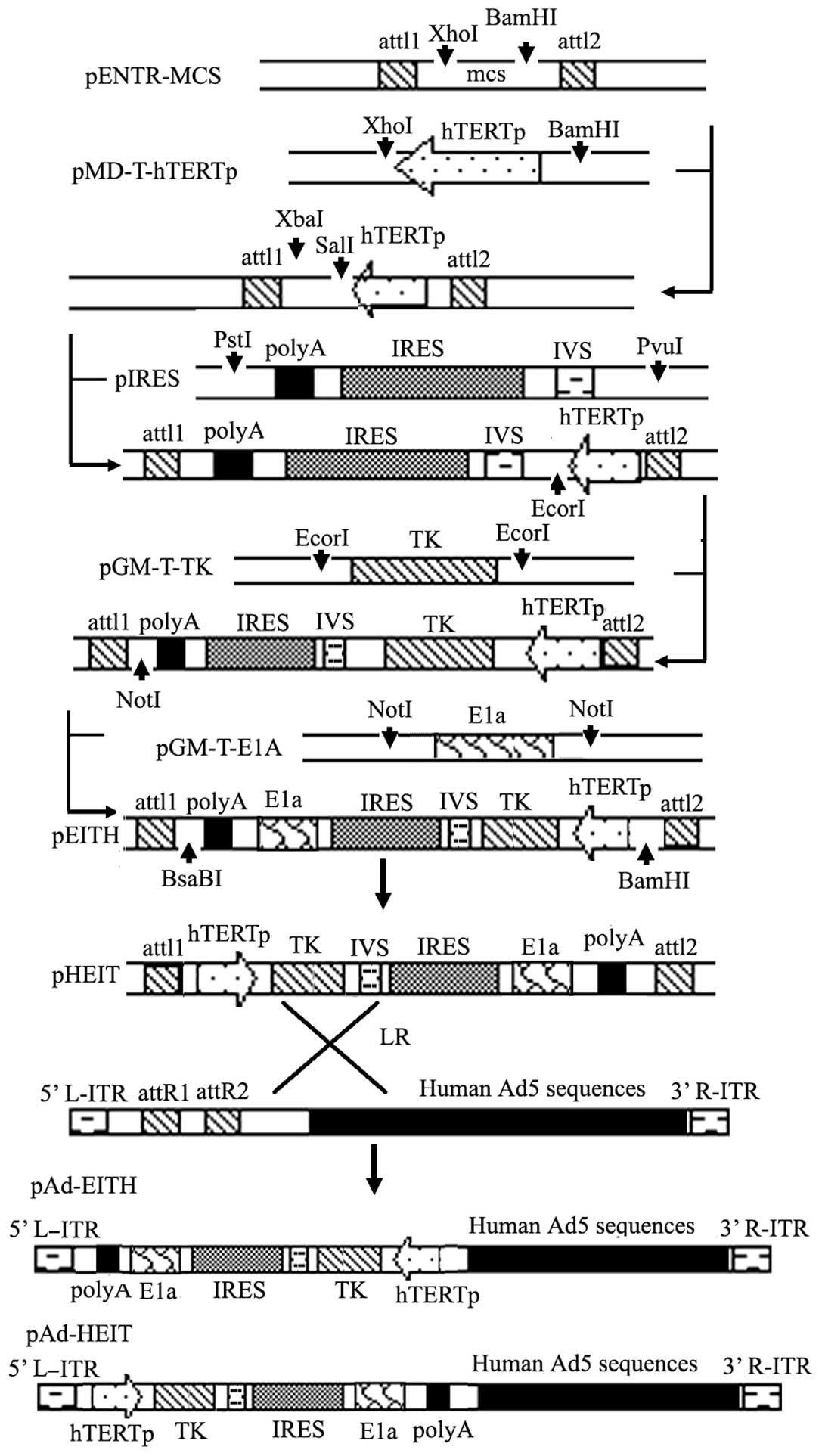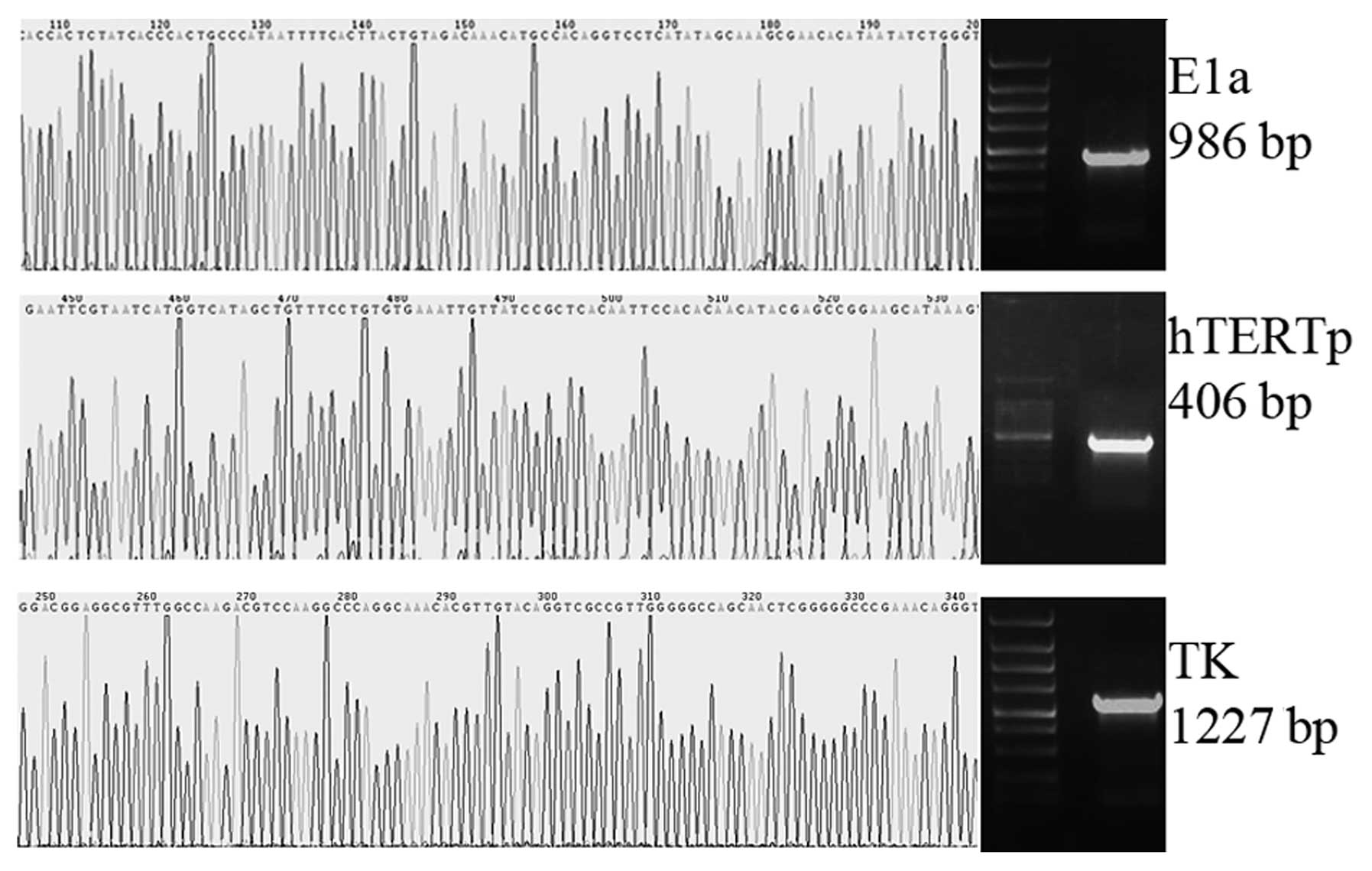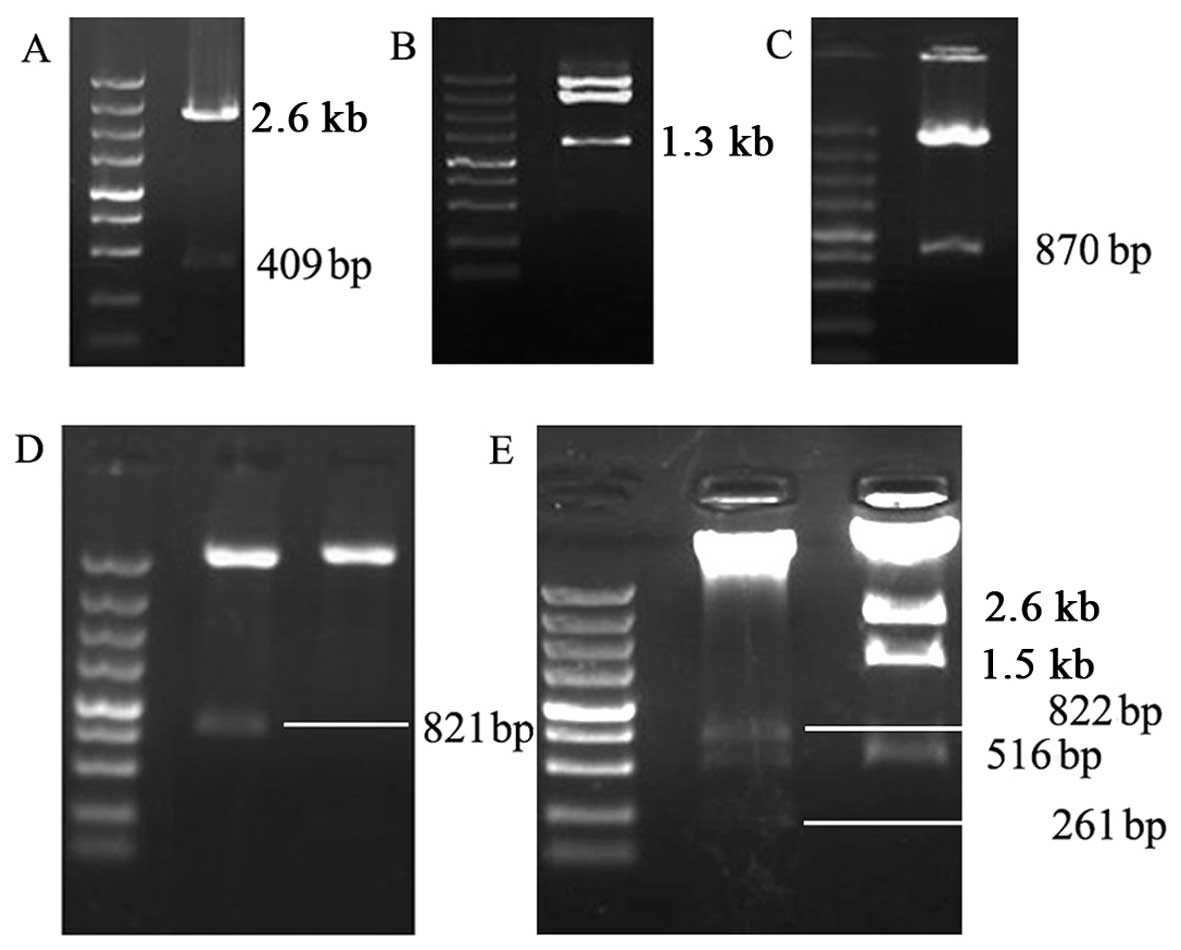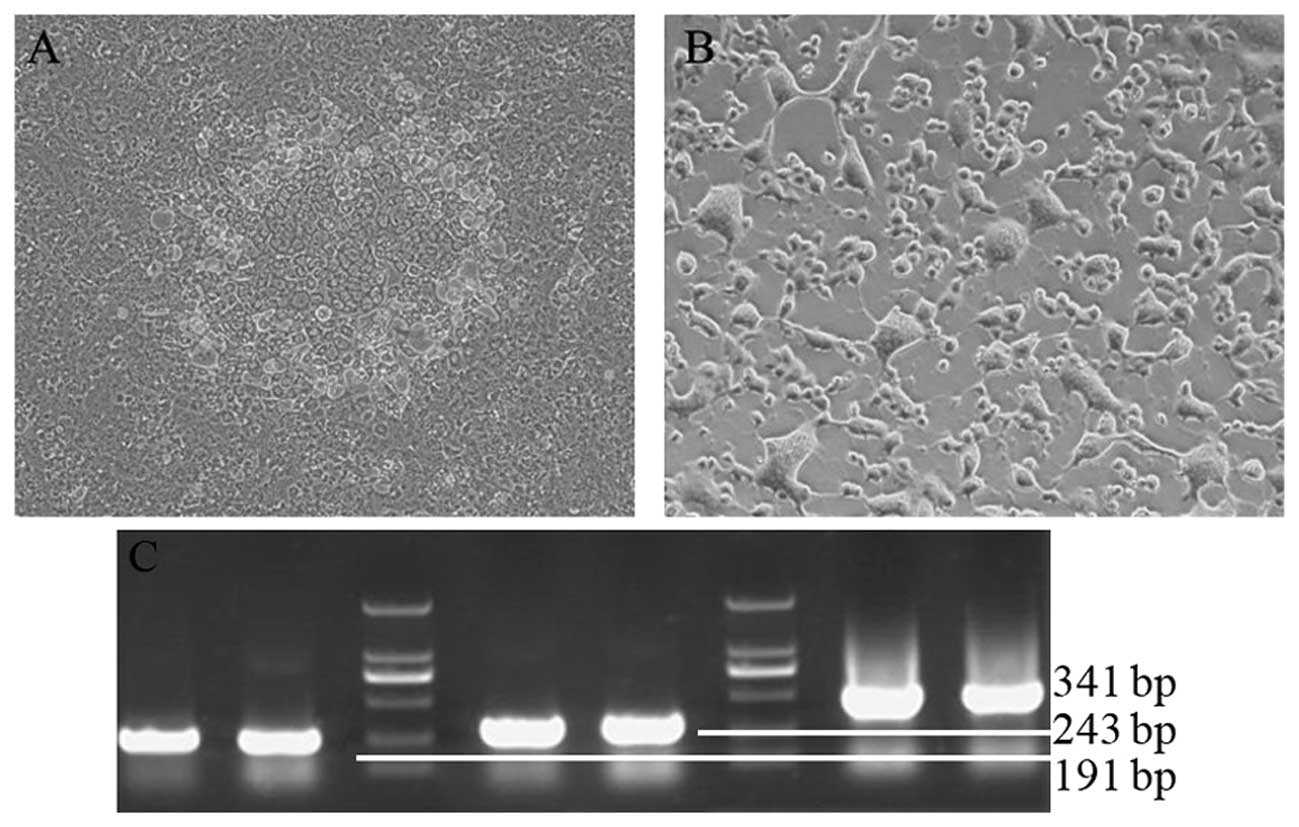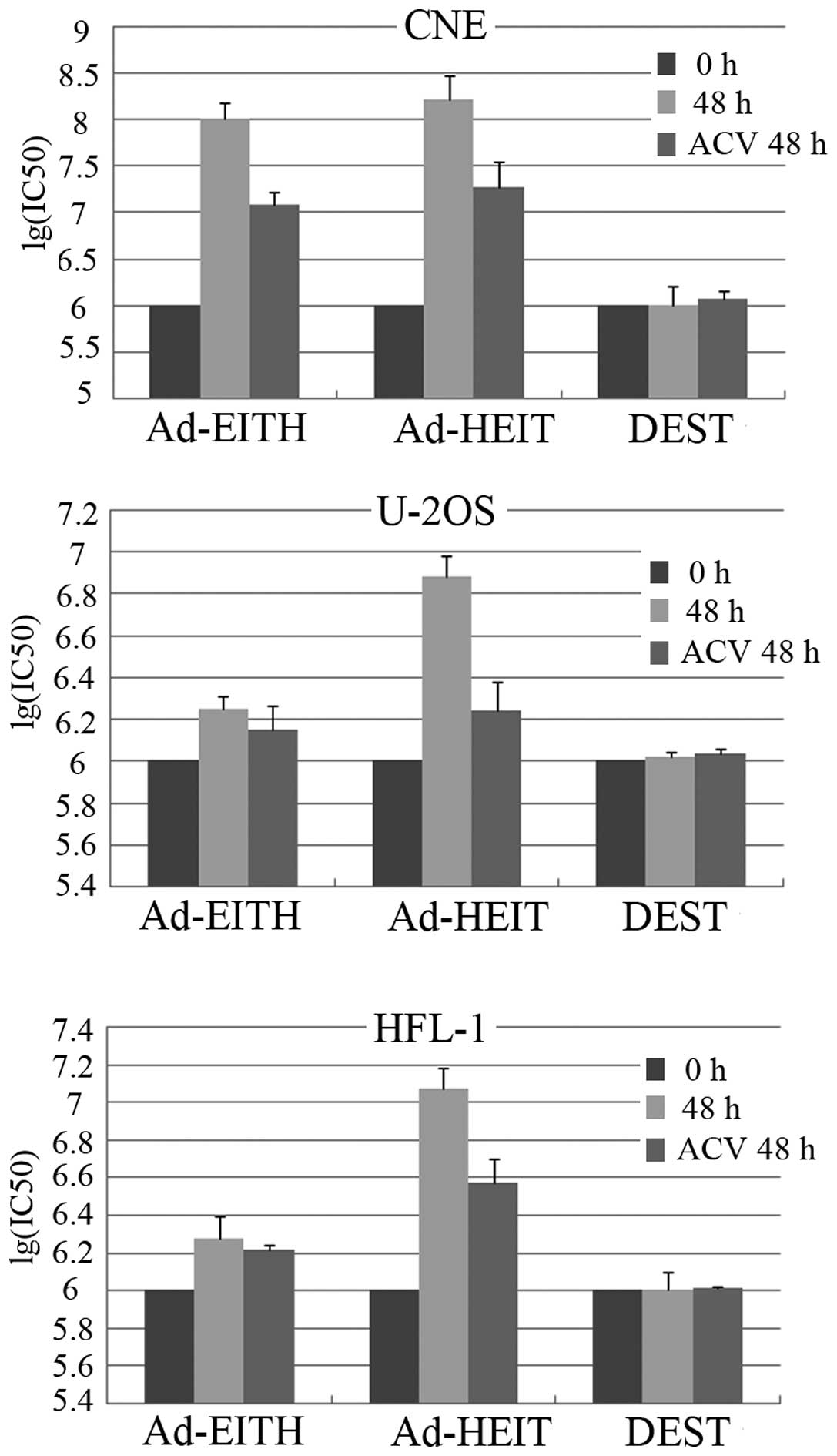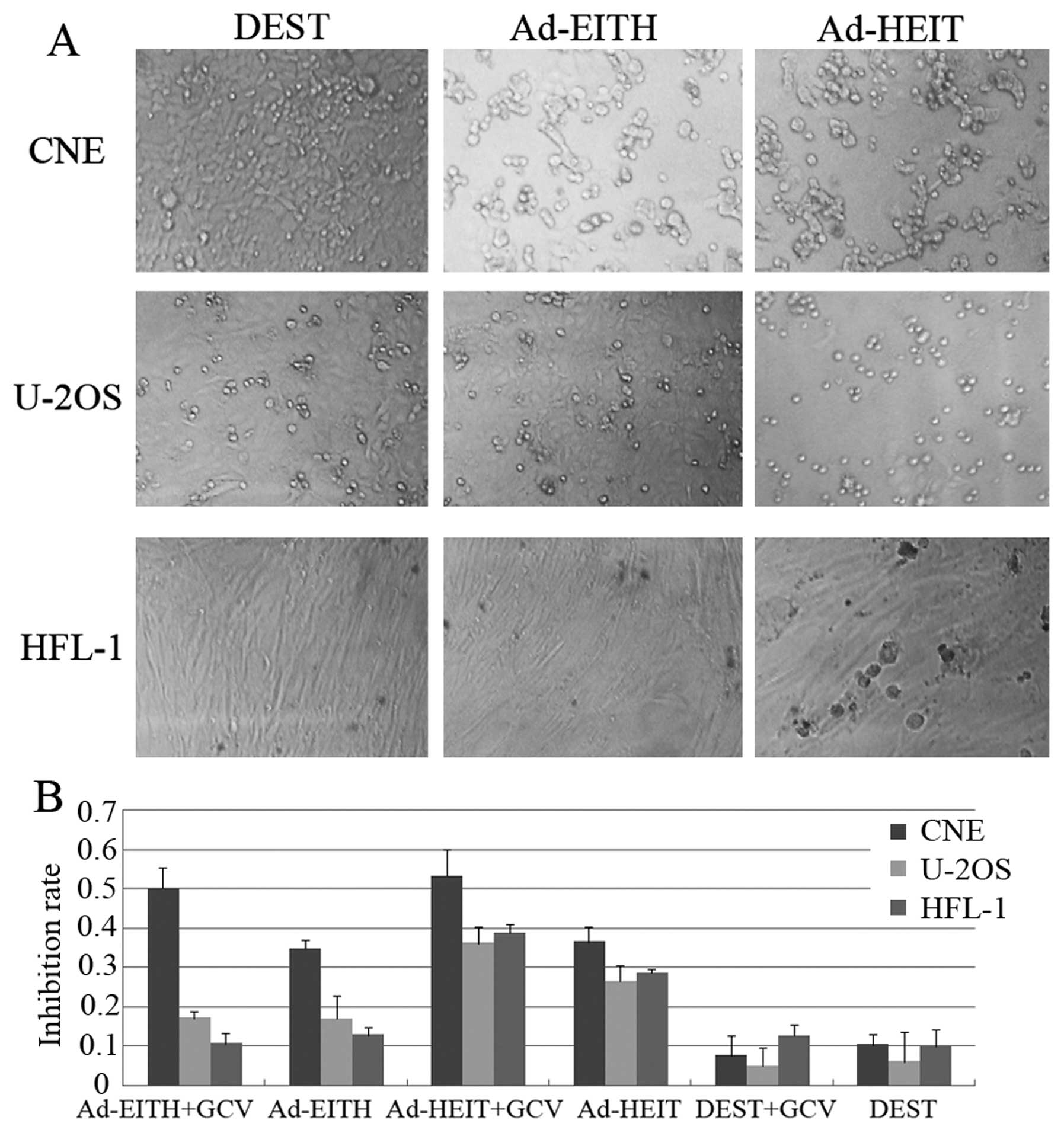Introduction
Cancer is a malignant disease which threaten human
life severely, and the traditional treatments include surgery,
chemotherapy and radiotherapy by which cancer can rarely be cured.
Gene therapy is a newly emerging therapeutic tool to treat cancer
with viral vectors and nonviral vectors, the viral vectors such as
adenovirus, retrovirus and herpesvirus have been used in
preclinical and clinical trials, and adenoviral vectors have even
been used in clinical treatments for cancer patients (1,2).
Adenoviral vectors are usually reconstructed to
replication defective vectors and oncolytic adenovirus (3). Replication defective vectors could not
spread overall into tumor tissue because of the low genetic
expression level. Oncolytic adenovirus, also referred to as
conditionally replicating adenovirus (CRAD), can selectively
replicate in tumor cells and cause cell lysis. The released viral
particles subsequently infect neighboring tumor cells and lead to
tumor lysis and regression, therefore construction of oncolytic
adenovirus was developed (4,5). On
the one hand, tumor-specific promoters were considerably used to
construct CRAD by driving replication-essential gene to control
viral replication in selective tumor cells. For example,
CRAB-CG7870 constructed by using PSA promoter to regulate E1A gene
was able to infect and kill prostatic carcinoma effectively in a
clinic trial (6). Other studies
have demonstrated that the promoter of catalytic subunit of human
telomerase (hTERTp) could be a good tumor-specific promoter
(7) and telomerase-selective
oncolytic adenoviral agents could significantly suppress cancer
growth (8,9). Exogenetic genes were utilized to
enhance the anticancer effectiveness of oncolytic adenovirus.
Suicide gene therapy by using the herpes simplex virus thymidine
kinase/ganciclovir (HSV-TK/GCV) system is a well-characterized tool
used in cancer gene therapy (10–12).
TK gene was able to transform ganciclovir (GCV) into GCV-TP which
inhibit DNA synthesis and induce host cells death, but suicide gene
such as TK gene also induced normal cells death, so the problem of
regulation of suicide gene expression needs to be resolved. Zhang
et al constructed expression vector by using TK gene
regulated by MDR1 promoter and improved the antitumor specificity
(13). Combination of
tumor-specific promoter and exogenetic antitumor gene has been
thought to be an ideal strategy for gene therapy, for example Zhang
et al(14) constructed
adenoviral vector by using TK gene and E1A gene regulated by the
promoter of catalytic subunit of human telomerase gene (hTERTp),
and demonstrated its potential antitumor value. Unfortunately,
further research found that a small number of viral particles could
infect and replicate in normal cells but let some malignant cells
slip away and enabled cancer survival (15,16),
so innovative construction of oncolytic adenovirus should be
performed for better effectiveness and specificity.
Left and right inverted terminal repeat (17–19) in
adenoviral genome as cis-acting elements are essential for viral
replication, and L-ITR sequence possesses promoter and enhancer
activity that could influence the expression of genes downstream,
and it was found that L-ITR contained the sole promoter for E1A
(20). In the present study,
adenoviral shuttle vector pENTR-hTERTp-E1A-IRES-TK (pHEIT) and
pENTR-E1A-IRES-TK-hTERTp (pEITH) carrying hTERTp, TK and E1A
elements were first cloned, and then LR reaction between adenoviral
shuttle vectors pHEIT and pEITH and backbone vector DEST was
carried out to establish adenoviral expression vector
pAd-E1A-IRES-TK-hTERTp (pAd-EITH) and pAd-hTERTp-E1A-IRES-TK
(pAd-HEIT). E1A-IRES-TK-hTERTp was inserted in pAd-EITH in reverse
direction of L-ITR and hTERTp to be ‘far away’ from the promoter
and enhancer sequence in L-ITR, which enabled a better specificity
for hTERT promoter, while E1A-IRES-TK-hTERTp was cloned to the
contrary in pAd-HEIT as a control.
Recombinant adenovirus Ad-E1A-IRES-TK-hTERTp
(Ad-EITH) and Ad-hTERTp-E1A-IRES-TK (Ad-HEIT) were produced by
using 293A cells and purified for the subsequent test of titer
measurement, replication capability with and without acyclovir and
antitumor ability with and without ganciclovir to study the
biological characteristics. As a results, we found that Ad-EITH
replicated more selectively in hTERTp (+) cells than Ad-HEIT
because tumor-specific promoter was used to control adenovirus
replication-essential gene E1A with little nonspecific regulation
effects by L-ITR. Suicide gene TK co-expressing with E1A not only
enhance the specific anticancer effect but also make recombinant
adenovirus Ad-EITH sensitive to the antiviral drug acyclovir which
means that we could utilize this characteristic to eliminate the
remaining viral vectors in the future clinical use, therefore we
supposed that Ad-EITH could be a potential oncolytic adenovirus
with better effectiveness and safety for cancer treatment.
Material and methods
Cell lines
Human embryonic kidney 293A cell line was purchased
from Invitrogen, human nasopharyngeal carcinoma cell line CNE,
human osteosarcoma cell line U-2OS and human lung fibroblasts HFL-1
were obtained from the Institute of Cell Biology at the Chinese
Academy of Sciences, Shanghai, China. 293A cells were grown in
Dulbecco’s modified Eagle’s medium supplemented with 10% fetal
bovine serum, 0.1 mM nonessential amino acid and 2 mM glutamine.
U-2OS cells were grown in McCoy’s 5a medium supplemented with 10%
fetal bovine serum and 1.5 mM glutamine. HFL-1 cells were grown in
MEMα medium supplemented with 10% fetal bovine serum. All the cells
were cultured at 37°C in a humidified incubator with 5%
CO2.
Plasmids, virus and bacterial
strains
All plasmids (pMD18-T, pGM-T, pENTR-MCS, DEST and
pIRES) used in this experiment were gifts by Professor Han Zhiqiang
of Zhengzhou University. Wild-type human herpes virus type 1 and
competent E. coli DH5α, TOP10 were gifts by Professor Han
Zhiqiang of Zhengzhou University.
Construction of cloning vectors
pMD18-T-hTERTp, pGM-T-TK and pGM-T-E1A
The 293A cells and wHSV-1 genome were extracted and
PCR primer were designed (Table I)
and fragments of hTERTp, E1A and HSV-1-TK were amplified by using
PCR from 293A cells and wHSV-1 genome, respectively, and cloned
into T-vectors by using T-A cloning technology to construct
pMD18-T-hTERTp, pGM-T-TK and pGM-T-E1A. Three cloning vectors were
identified by sequencing.
 | Table IAmplification and identification
primers. |
Table I
Amplification and identification
primers.
| Primers | Size (bp) |
|---|
| E1a amplification
primer |
atgagacatattatctgcca | |
|
tatggcctggggcgtttacag | 986 |
| hTERTp amplification
primer |
cgattcgacctctctccgctggggc | |
|
cagggcttcccacgtgcgcagcag | 406 |
| TK amplification
primer |
aagaggtgcgggagtttc | |
|
ctatgacggcaataaaaa | 1227 |
| E1a identification
primer |
tgatcgatcttacctgccac | |
|
ccaaacccaccactctatc | 243 |
| hTERTp identification
primer |
tggattcgcgggcacagac | |
|
gcggaaaggaaggggaggg | 191 |
| TK identification
primer |
cgtacccgagccgatgact | |
|
tgagggccacgaacgccag | 341 |
Construction of adenovirus shuttle
vectors pEITH and pHEIT
Elements of hTERTp, TK, E1A and IRES were cloned
into pENTR-MCS by using restriction enzyme and recombinant DNA
technology to construct adnovirus shuttle vectors pEITH and pHEIT.
All the clones and subclones constructed in this process were
identified by restriction enzyme analysis. The strategy of
construction is shown in Fig.
1.
Construction of adnovirus expression
vectors pAd-EITH and pAd-HEIT
LR reaction between adenoviral shuttle vector (pEITH
and pHEIT) and backbone vector DEST was carried out to establish
adenoviral expression vectors pAd-EITH and pAd-HEIT in accordance
with the manufacturer’s instructions: 0.5 μl pEITH (pHEIT) +0.8 μl
DEST +6.7 μl Eluent +2 μl LR recombinase, 25°C overnight.
Transformed clones were identified by BamHI restriction
enzyme analysis.
Production of recombinant adenovirus
Ad-EITH and Ad-HEIT
Packaging
The 293A cells were seeded at a density of
5×105 cells per well in 6-well plates and transfected
with linearized pAd-EITH and pAd-HEIT by using Liposome 2000, cells
and supernatant were harvested until ~80% cytopathic effect (CPE)
was observed (5–7 days post-transfection). Cells were lysed to
release intracellular viral particles by three freeze/thaw cycles.
The cell lysate was then centrifuged at 5000 rpm for 15 min at room
temperature to pellet the cell debris. The supernatant was then put
through a 0.22-μm filter and transferred to cryovials in 1 ml
aliquots.
Amplification
Isolated plaques of recombinant adenovirus were
picked and expanded by infecting 293A cells. On the day before
infection, 3×106 cells were prepared per 10-cm plate. On
the day of infection, the desired amount of virus was added to the
cells (MOI=10) at 80–90% confluence. The cells and supernatant were
harvested, frozen and thawed three times, the cell lysate was
centrifuged and stored at −80°C.
Identification
The genome of isolated plaques of recombinant
adenovirus Ad-EITH and Ad-HEIT was extracted, the identification
primer of hTERTp, TK and E1A was designed (Table I) for PCR amplification.
Concentration and purification
The virus mixture solution was transfered with 1.37,
1.32 and 1.27 g/ml CsCl successively to a tube for SW40 rotor, and
the balance tube was prepared. The gradient in an SW40 rotor was
centrifuged at 35000 rpm, 4°C for 18 to 24 h. Virus fraction was
collected by puncturing the tube just below the virus band and
drawing the virus down into the needle. The virus solution was
transfered into PBS dialysis cassette for 1–2 h, changing the
buffer to fresh PBS with 10% glycerol after the first dialysis and
dialyzing overnight then quantifying the virus before storing at
−80°C. The titer was determined according to TCID50 methods based
on plaque-forming unit assay (1,2).
Evaluation of characteristics of
replication
Replication-deficient adenovirus DEST was used as
negative control to evaluate the replication ability of Ad-EITH and
Ad-HEIT in CNE cells (hTERT+), U-20S cells
(hTERT-) and normal human cells HFL-I
(hTERT-). Cells (1×105) were seeded in 6-well
plates on the day of infection. Viruses were used to infect cells
at MOI=10 for 48 h. Cells and supernatant were then harvested and
titrated. The replication ability of viruses was evaluated
according to the titer.
Sensitivity of Ad-EITH and Ad-HEIT to ACV on account
of HSV-TK gene inserted in viral genome was also evaluated in this
study. The 293A cells were infected by Ad-EITH, Ad-HEIT and DEST as
control for 1.5 h and washed by PBS, then cultured in DMEM media
with 10 μg/ml ACV and without serum for 48 h. Cells and supernatant
were harvested and titrated. The ACV-sensitivity of viruses was
then evaluated according to the titer.
Cytotoxicity assay
Cell counting kit-8 (CCK-8) was used for recombinant
adenoviruses Ad-EITH and Ad-HEIT cytotoxicity assay to three kinds
of tumor cells. First, 100 μl of cell suspension (1×104
cells/well) in a 96-well plate was dispensed, and Ad-EITH, Ad-HEIT
and DEST were added into the culture media in the plate (MOI=1),
other groups were also added with the three viruses at 10 μg/ml
GCV. The plates were incubated for 4 days in humidified incubator
then CCK-8 solution was added to each well for assay. The
absorbance at 450 nm was measured using a microplate reader after
incubating the plate for 4 h. Inhibition rates then were
measured.
Statistical analysis
Statistical analysis was performed with one-way
ANOVA and t-test. Statistical significance was set at
P<0.05.
Results
Construction of pMD-T-hTERTp, pGM-T-TK
and pGM-T-E1A
hTERTp (406 bp), E1A (986 bp) and HSV-1-TK gene
(1227 bp) were successfully amplified from the 293A cell genome and
wHSV-1 genome respectively, and then pMD-T-hTERTp, pGM-T-TK and
pGM-T-E1A were constructed by T-A cloning technology and identified
by sequencing (Fig. 2).
Construction of pEITH, pHEIT and
pAd-EITH, pAd-HEIT
Vector pENTR-hTERTp was cloned by inserting hTERTp
into vector pENTR-MCS, recombined vectors were identified by
restriction enzyme analysis (BamHI and XhoI), correct
clone could be cut off to 409 bp and 2.6 kb fragments (Fig. 3). IRES element was cloned into
pENTR-hTERTp to obtain pENTR-hTERTp-IRES, 1.3 kb could be cut off
from correct clone by BamHI restriction enzyme (Fig. 3). The TK gene was inserted
downstream of the hTERTp into pENTR-hTERTp-IRES to establish
pENTR-hTERTp-TK-IRES, XbaI was used in the identification
(Fig. 3). pEITH was constructed by
inserting E1A gene into pENTR-hTERTp-TK-IRES downstream of IRES and
in pEITH hTERTp-TK-IRES-E1A was located downstream of recombination
site attL2 with the same direction, hTERTp-TK-IRES-E1A was cut off
and inserted into pENTR-MCS in the opposite direction compared with
pEITH. Vectors pEITH and pHEIT were identified by SphI
(Fig. 3).
LR reaction between adenoviral shuttle vector (pEITH
and pHEIT) and backbone vector DEST was carried out to establish
adenoviral expression vector pAd-EITH and pAd-HEIT, and
BamHI was used in the identification (Fig. 3).
Preparation of recombinant
adenovirus
Adenovirus expression vectors were linearized by
PacI and transfected into 293A cells to package recombinant
adenovirus, and the supernatant was harvested until ~80% CPE was
observed (Fig. 4). Isolated plaques
of recombinant adenovirus were also picked to obtain the monoclonal
virus (Fig. 4). Amplified crude
viruses were concentrated and purified with >1011
PFU/ml. The genome of isolated plaques of recombinant adenovirus
Ad-EITH and Ad-HEIT, was extracted and the hTERTp, E1A and TK gene
was identified by PCR, the results showed hTERTp, E1A and TK were
successfully cloned into the adenoviral genome (Fig. 4).
Replication of recombinant adenoviruses
and sensitivity to ACV
The replication ability of Ad-EITH and Ad-HEIT and
their sensitivity to ACV in CNE cells (hTERT+), U-2OS
cells (hTERT-) and nomal human cells HFL-1 were
evaluated. Results showed that Ad-EITH and Ad-HEIT could both
replicate in CNE cells effectively with titer up to
108.01 PFU/ml and 108.22 PFU/ml after 48 h
with no significant difference (P>0.05). while replication
ability of Ad-EITH in hTERT (−)U-2OS and human normal HFL-1 cells
was weaken obviously and was hardly able to replicate in the cells
(titer were up to 106.25 PFU/ml in U-2OS cells and
106.28 in HFL-1 cells). Ad-HEIT replicated in U-2OS and
HFL-1 cells at a higher level than Ad-EITH (P<0.05), and the
titer increased to 106.88 PFU/ml and
107.07PFU/ml in U-2OS cells and HFL-1 cells (Fig. 5). In addition, the replication of
Ad-EITH and Ad-HEIT was inhibited by ACV. In CNE cells at 10 μg/ml
ACV, and the titer of Ad-EITH and Ad-HEIT were up to
107.08 PFU/ml and 107.27 PFU/ml, both lower
than that in CNE cells without ACV (P<0.05), moreover in U-2OS
and HFL-1 cells with ACV, replication of Ad-EITH and Ad-HEIT was
also inhibited (Fig. 5) and control
virus DEST could not replicate in any of the cells (Fig. 5).
Cytotoxicity assay
Cytotoxicity of recombinant adenoviruses Ad-EITH and
Ad-HEIT to tumor cells was evaluated by CCK-8 assay. Morphology
observation showed that the three cell types infected by DEST could
still grow without obvious morphological changes. While CNE cells
infected by Ad-EITH and Ad-HEIT had CPE consisting of cell
rounding, disorientation, swelling or shrinking, detachment from
the surface and fusion. Compared to Ad-HEIT, Ad-EITH showed less
cytotoxicity to U-2OS and HFL-1 cells with slight CPE, most U-2Os
and HFL-1 cells infected by Ad-EITH could grow similarly to the
DEST group (Fig. 6).
Results of CCK-8 assay showed that Ad-EITH and
Ad-HEIT killed CNE cells effectively with 34.7 and 36.4% inhibition
rate, respectively, at MOI=1 (P>0.05), but Ad-EITH could not
inhibit the growth of U-2OS and HFL-1 cells well compared to
Ad-HEIT, which still killed 26.4 and 28.6% U-2OS and HFL-1 cells,
that mean Ad-EITH had a better specificity to kill hTERTp (+) tumor
cells than Ad-HEIT. Results also showed that GCV enhanced the
antitumor effects of Ad-EITH and Ad-HEIT because of the suicide
gene TK. The inhibition rates of Ad-EITH and Ad-HEIT were 50.1 and
53.1% to CNE cells with 10 μg/ml GCV, higher than that without GCV
34.7 and 36.4% (P<0.05). However, DEST also had 12.9, 14.5 and
5.5% inhibition rates to the three cells probably because of some
nonspecific effect of virus particles (Fig. 6).
Discussion
There are many limitations for traditional therapies
including chemotherapy, surgery in cancer treatment, so
developments of safe and effective biotherapies have been focused
on, in recent years. Gene therapy has been used with success and
has many advantages. Construction of efficient and safe vectors is
the key for gene therapy, and viral vectors are mostly used in gene
therapy. Gendicine, an adenoviral p53-based gene therapy was
approved by the Chinese food and drug regulators in 2003 for
treatment of head and neck cancer. Advexin, a similar gene therapy
approach from Introgen, was turned down by the US Food and Drug
Administration (FDA) in 2008 (21).
However, these replication-defective viral vectors had many
problems relating to patient toxicity, immune and inflammatory
responses, and gene control and targeting issues, therefore,
replication-competent viral vectors (oncolytic virus) were
developed (12). It was found that
in the absence of replication-essential genes or by using
tumor-specific promoters, recombinant viruses could replicate in
tumor cells specifically, cause rapid apoptosis of infected cells
and result in massive killing of cells with no influence to normal
cells. The foreign gene such as the suicide gene could be inserted
into oncolytic virus to enhance the antitumor effects. HSV-TK/GCV
suicide gene therapy has been used in clinical trial and has
resulted in some clinical improvement (22). Moreover, many new therapeutic
methods and tools have been emerging in large numbers to improve
the effectiveness and safety of gene therapy in cancer treatment
(23).
Herein, we utilized adenovirus as the therapeutic
vector to construct a novel recombinant adenoviral expression
vector pAd-EITH which could co-express E1A and HSV-1-TK gene by
using hTERT promoter and IRES element, and we also cloned the
hTERTp-TK-IRES-E1A downstream L-ITR with reverse direction and
hTERTp was distant from the L-ITR in consideration of the promoter
and enhancer activity of L-ITR for better replication specificity.
We also constructed pAd-HEIT in which hTERTp-TK-IRES-E1A downstream
of L-ITR with the same direction to compare the difference of
replication and antitumor characteristics between Ad-EITH and
Ad-HEIT in tumor cells. Then, recombinant adenoviruses Ad-EITH and
Ad-HEIT were produced by transfected linearized pAd-EITH and
pAd-HEIT DNA and the replication activity and antitumor
characteristics were evaluated. Results showed that Ad-EITH and
Ad-HEIT replicated in hTERTp (+) human nasopharyngeal carcinoma
cell line CNE cells effectively, but in hTERTp (−) human
osteosarcoma cell line U-2OS cells and human lung fibroblasts HFL-1
cells, Ad-EITH was hardly able to replicate while Ad-HEIT still
replicated in a small quantity, therefore we considered that 5′
L-ITR could disturb the regulation of the promoter and expression
of gene downstream, which reduced the specificity of Ad-HEIT. To
our surprise, the results in ACV sensitivity assay showed that ACV
inhibited the replication of Ad-EITH and Ad-HEIT. ACV can induce
the inhibition of viruses (especially HSV-1) replication by
inhibiting DNA synthesis of the host cells. TK gene in Ad-EITH and
Ad-HEIT was amplified from the genome of wHSV-1 sensitive to
antivirus drug ACV in clinic and cloned into Ad-EITH and Ad-HEIT,
so that these two recombinant adenoviruses could be sensitive to
ACV such as wHSV-1.
In our study, we demonstrated that Ad-EITH could
inhibit the growth of CNE with no significant difference from
Ad-HEIT, while the cytotoxicity of Ad-EITH to U-2OS and HFL-1 cells
were subdued because of the improved replication specificity. The
results also showed that GCV enhanced the antitumor effects of
Ad-EITH and Ad-HEIT because the expression of the TK gene could
transform GCV to a cytotoxic product and induced bystander effects
among tumor cells in vitro. Hence, we thought that
recombinant adenovirus Ad-EITH had better replication specificity
compared to Ad-HEIT, and improved effectiveness and safety because
of the HSV-1-TK gene, which not only enhanced the antitumor effect
simultaneously but also caused Ad-EITH sensitivity to ACV, which
meant that we could use ACV to eliminate residual therapeutic
viruses and reduce side effects in future clinical application. TK
gene and E1A gene were regulated by the same promoter hTERTp and
co-expressed, to make sure that non-target cells would not be
damaged by TK gene expression. Ad-EITH replicated conditionally in
P53 (−) cells because of the deleted E1B-55 kd gene, whereas E1A
was regulated by hTERTp to make sure Ad-EITH replicated in tumor
cells expressing specifically the hTERTp.
Ad-EITH is a potential novel oncolytic adenovirus
that kills tumor cells effectively and specifically with
sensitivity to ACV improving the safety of Ad-EITH greatly. Further
study in vivo and in clinic trials need to be carried out to
obtain more evidence for future clinical application.
References
|
1
|
Swisher SG, Roth JA, Komaki R, Gu J, Lee
JJ, Hicks M, Ro JY, Hong WK, Merritt JA, Ahrar K, Atkinson NE,
Correa AM, Dolormente M, Dreiling L, El-Naggar AK, Fossella F,
Francisco R, Glisson B, Grammer S, Herbst R, Huaringa A, Kemp B,
Khuri FR, Kurie JM, Liao Z, McDonnell TJ, Morice R, Morello F,
Munden R, Papadimitrakopoulou V, Pisters KM, Putnam JB Jr, Sarabia
AJ, Shelton T, Stevens C, Shin DM, Smythe WR, Vaporciyan AA, Walsh
GL and Yin M: Induction of p53-regulated genes and tumor regression
in lung cancer patients after intratumoral delivery of adenoviral
p53 (INGN 201) and radiation therapy. Clin Cancer Res. 9:93–101.
2003.PubMed/NCBI
|
|
2
|
Gabrilovich DI: INGN 201 (Advexin):
adenoviral p53 gene therapy for cancer. Expert Opin Biol Ther.
6:823–832. 2006. View Article : Google Scholar : PubMed/NCBI
|
|
3
|
Liu XY: Targeting gene-virotherapy of
cancer and its prosperity. Cell Res. 16:879–886. 2006. View Article : Google Scholar : PubMed/NCBI
|
|
4
|
Pin RH, Reinblatt M and Fong Y: Utilizing
alpha-fetoprotein expression to enhance oncolytic viral therapy in
hepatocellular carcinoma. Ann Surg. 240:659–666. 2004.PubMed/NCBI
|
|
5
|
Jakubczak JL, Ryan P, Gorziglia M, Clarke
L, Hawkins LK, Hay C, Huang Y, Kaloss M, Marinov A, Phipps S,
Pinkstaff A, Shirley P, Skripchenko Y, Stewart D, Forry-Schaudies S
and Hallenbeck PL: An oncolytic adenovirus selective for
retinoblastoma tumor suppressor protein pathway-defective tumors:
dependence on E1A, the E2F-1 promoter, and viral replication for
selectivity and efficacy. Cancer Res. 63:1490–1499. 2003.
|
|
6
|
Dilley J, Reddy S, Ko D, Nguyen N, Rojas
G, Working P and Yu DC: Oncolytic adenovirus CG7870 in combination
with radiation demonstrates synergistic enhancements of antitumor
efficacy without loss of specificity. Cancer Gene Ther. 12:715–722.
2005. View Article : Google Scholar
|
|
7
|
Uchino J, Takayama K, Harada A, Kawakami
Y, Inoue H, Curiel DT and Nakanishi Y: Infectivity enhanced, hTERT
promoter-based conditionally replicative adenoviruses are useful
for SCLC treatment. Cancer Gene Ther. 12:737–748. 2005. View Article : Google Scholar : PubMed/NCBI
|
|
8
|
Irving J, Wang Z, Powell S, O’Sullivan C,
Mok M, Murphy B, Cardoza L, Lebkowski JS and Majumdar AS:
Conditionally replicative adenovirus driven by the human telomerase
promoter provides broad-spectrum antitumor activity without liver
toxicity. Cancer Gene Ther. 11:174–185. 2004. View Article : Google Scholar
|
|
9
|
Zou W, Luo C, Zhang Z, Liu J, Gu J, Pei Z,
Qian C and Liu X: A novel oncolytic adenovirus targeting to
telomerase activity in tumor cells with potent. Oncogene.
23:457–464. 2004. View Article : Google Scholar : PubMed/NCBI
|
|
10
|
Tang XJ, Wang YP, Zhou QH, Che GW, Chen XH
and Zhu DX: A study on selective killing effect of Hsv-tk/GCV
driven by human telomerase catalytic subunit promoter on human lung
cancer cell A549. Zhonghua Yi Xue Yi Chuan Xue Za Zhi. 24:148–152.
2007.(In Chinese).
|
|
11
|
Painter RG, Lanson NA Jr, Jin Z, Park F
and Wang G: Conditional expression of a suicide gene by the
telomere reverse transcriptase promoter for potential
post-therapeutic deletion of tumorigenesis. Cancer Sci. 96:607–613.
2005. View Article : Google Scholar : PubMed/NCBI
|
|
12
|
Jiang YX, Lu Y, Liu TJ, Yang J, Chen Y and
Fang YW: Using HSV-TK/GCV suicide gene therapy to inhibit lens
epithelial cell proliferation for treatment of posterior capsular
opacification. Mol Vis. 17:291–299. 2011.PubMed/NCBI
|
|
13
|
Zhang Y, Wang CW, Wang ZG, Ma DX, Pan S,
Zhu SG, Li F and Wang B: Construction of double suicide genes
system controlled by MDR1 promoter with targeted expression in
drug-resistant glioma cells. J Neurooncol. 86:3–11. 2008.
View Article : Google Scholar : PubMed/NCBI
|
|
14
|
Huagn Y, Xu YM, Zhang JW, Ren XH and Suo
AQ: Effects of estrogen on P-Tau, ChAT and nerve growth factor
protein expressions in the brain tissue of rats with Alzheimer’s
disease. Nan Fang Yi Ke Da Xue Xue Bao. 30:2408–2410. 2010.(In
Chinese).
|
|
15
|
Geoerger B, Grill J, Opolon P, Morizet J,
Aubert G, Lecluse Y, van Beusechem VW, Gerritsen WR, Kirn DH and
Vassal G: Potentiation of radiation therapy by the oncolytic
adenovirus dl1520 (ONYX-015) in human malignant glioma xenografts.
Br J Cancer. 89:577–584. 2003. View Article : Google Scholar : PubMed/NCBI
|
|
16
|
Khuri FR, Nemunaitis J, Ganly I, Arseneau
J, Tannock IF, Romel L, Gore M, Ironside J, MacDougall RH, Heise C,
Randlev B, Gillenwater AM, Bruso P, Kaye SB, Hong WK and Kirn DH: A
controlled trial of intratumoral ONYX-015, a
selectively-replicating adenovirus, in combination with cisplatin
and 5-fluorouracil in patients with recurrent head and neck cancer.
Nat Med. 6:879–885. 2000. View
Article : Google Scholar : PubMed/NCBI
|
|
17
|
Xing L and Tikoo SK: E1A promoter of
bovine adenovirus type 3. J Gen Virol. 87:3539–3544. 2006.
View Article : Google Scholar : PubMed/NCBI
|
|
18
|
Yamamoto M, Davydova J, Takayama K,
Alemany R and Curiel DT: Transcription initiation activity of
adenovirus left-end sequence in adenovirus vectors with e1 deleted.
J Virol. 77:1633–1637. 2003. View Article : Google Scholar : PubMed/NCBI
|
|
19
|
Li C, Hirsch M, Carter P, Asokan A, Zhou
X, Wu Z and Samulski RJ: A small regulatory element from chromosome
19 enhances liver-specific gene expression. Gene Ther. 16:43–51.
2009. View Article : Google Scholar : PubMed/NCBI
|
|
20
|
Reed LJ and Muench H: A simple method of
estimating fifty percent endpoints. Am J Hygiene. 27:493–497.
1938.
|
|
21
|
Bischoff JR, Kirn DH, Williams A, Heise C,
Horn S, Muna M, Ng L, Nye JA, Sampson-Johannes A, Fattaey A and
McCormick F: An adenovirus mutant that replicates selectively in
p53-deficient human tumor cells. Science. 274:373–376. 1996.
View Article : Google Scholar : PubMed/NCBI
|
|
22
|
Niculescu-Duvaz I and Springer CJ:
Introduction to the background, principles, and state of the art in
suicide gene therapy. Mol Biotechnol. 30:71–88. 2005. View Article : Google Scholar : PubMed/NCBI
|
|
23
|
Zhang X, Zhao L, Hang Z, Guo H and Zhang
M: Evaluation of HSV-1 and adenovirus vector-mediated infection,
replication and cytotoxicity in lymphoma cell lines. Oncol Rep.
26:637–644. 2011.PubMed/NCBI
|















